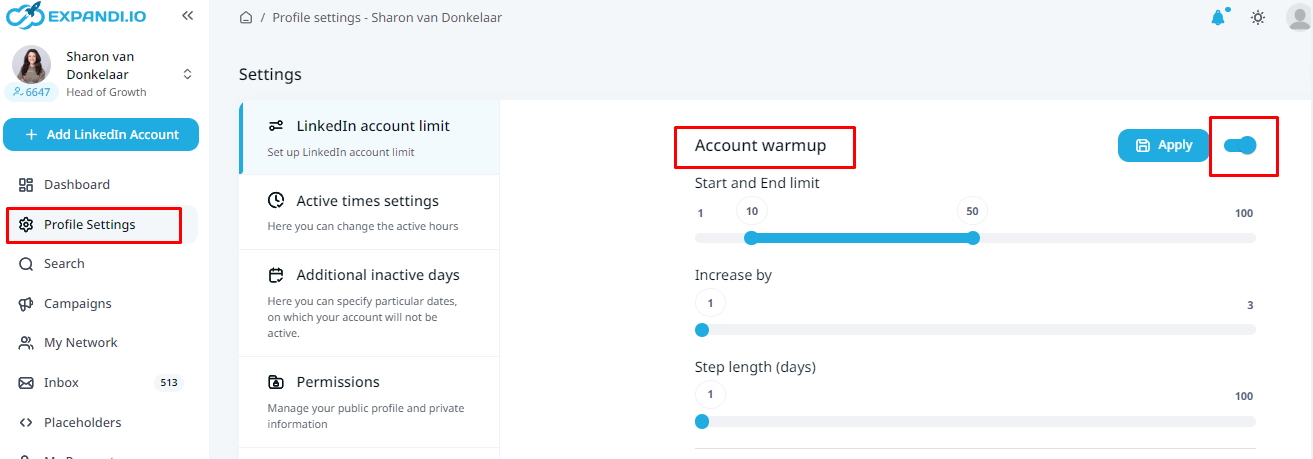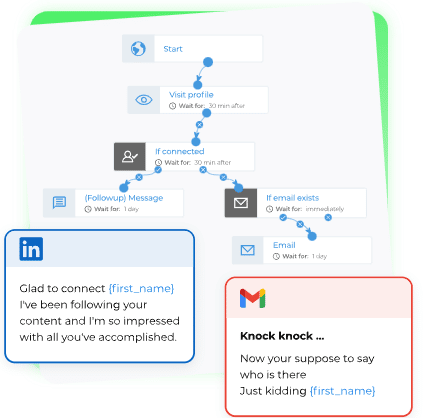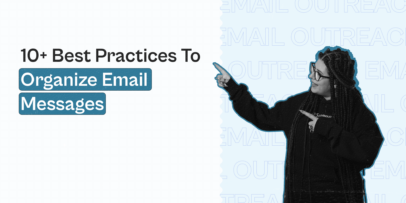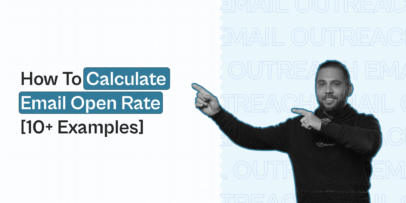Email Outreach Tracking: 7 Things to Consider to Get the Most Out of Your Outreach
Sending cold email campaigns without outreach tracking is a shot in the dark.
Without knowing your email outreach analytics, you’ll never be able to measure how well your campaigns are performing.
Alternatively, let’s say you are tracking your email data and you saw that your emails got an average open rate of 55%.
Is that a good thing?
Maybe. But you also need to consider some of your other email metrics (e.g. reply rate, click rate, etc.) as well as your industry outreach email averages.
That is to say, your email outreach tracking doesn’t exist in a vacuum.
Now, to make your job easier, we’ve identified the best email outreach tracking KPIs, metrics, and data you should be monitoring in your campaigns.
Without knowing those numbers, you won’t be able to optimize your email outreach.
And to make things even better, we’ll also show you how to leverage your data points to make your email outreach even more effective.
With that said, here’s what we’ll cover in this ultimate guide to email outreach tracking:
- How To Warm Up Your Email Inbox For Safer And More Effective Outreach
- Top 5 Email Outreach Metrics To Track And How To Boost Their Performance
- 3 Key Ways To Boost Your Email Outreach Efforts

But before we get started…
Are you in our private Facebook group, The LinkedIn Outreach Family yet?
In it, we cover all the latest outreach best practices, growth hacks, and marketing knowledge to help you generate leads. So, be sure to join and say ‘hi’!
Now, let’s get started.
How To Warm Up Your Email Inbox For Safer And More Effective Outreach
Now, before we get started on the actual email outreach tracking metrics, there’s something important you should know:
A lot of the success of your email campaigns depends heavily on how warmed up your inbox is.
Ideally, you should follow this step before doing any outreach. And if you do, you’ll see a drastic increase in your email deliverability. That is to say, your emails will be landing in your leads’ inboxes – not the spam or promotions folder.
Essentially, this is a way to establish a reputation with your domain and increase your daily sending limit.
And this applies to your email outreach as well as LinkedIn.
So, let’s get this out of the way briefly.
How to warm up your email inbox for outreach
If you’re getting suspiciously low email open rates, a high bounce rate, or your emails are landing in the spam folder, chances are, you might have done the technical setup wrong!
This typically happens with a new domain or an email inbox that is not warmed up.
Google provides 2,000 emails a day for G Suite accounts. But you can’t send it all at once, as Google gives you a smaller limit.
To use it to its fullest potential, you need a good reputation, which you can gain by warming up your email inbox.
Typically, this takes up to 4 weeks but fortunately, it can be automated. So, you won’t have to send emails back and forth daily manually.
Warming up your inbox is simple.
You have to:
- Set up a G Suite DKIM record. Essentially, this vouches for your authenticity when sending emails.
- Authorize SPF (Sender Policy Framework) record that lists all the servers authorized to send emails on behalf of a domain.
- Set up DMARC (domain-based message authentication, reporting & conformance) to indicate your messages are protected by SPF and DKIM. This tells your email recipients what to do if neither of those authentication methods passes (spam or reject the message).
- And finally, you’ll need to use an email warming up tool to send sample emails back and forth with other users. This will automate sending sample emails to other users who also want to warm up their emails, and show the domain that your emails are getting clicks and replies.
This may sound like complicated technical settings, but it’s easier than you think.
See our full guide on email warmup to learn how to go through the above checklist and some of our favorite email warmup tools.
How to warm up your LinkedIn account for automated outreach
Now, in case you’re doing outreach on LinkedIn, let’s take a look at how to prepare for outreach there.
A similar concept applies to LinkedIn, but with a slight difference.
If you’re sending too many LinkedIn connection requests and messages per day, you might risk getting your LinkedIn account suspended.
To avoid that, you’ll want to start small.
To ensure your automated outreach mimics human behavior and your account doesn’t get blocked, we recommend starting out slow with your LinkedIn outreach. Something along the lines of:
- 1-5 days – 10 connection requests per day.
- 5-10 days – 20 connection requests per day.
- 15-20 days – 30 connection requests per day.
- 20-25 days – 50 connection requests per day.
Fortunately, you can also do this on autopilot with tools like Expandi.

For a more detailed breakdown of this, see our full guide on LinkedIn connection limit.
Now, let’s get back on track and go over email outreach tracking KPIs.
Top 7 Email Outreach Metrics To Track And How To Boost Their Performance
Wondering if your email outreach is performing well or if your KPIs are above the industry average?
To make your life easier, we’ll be taking a look at some of the essential email metrics, their industry averages to compare your data to, as well as how to boost your email outreach in general.
The email outreach tracking KPIs we’ll be looking at include:
- Email open rate
- Reply rate
- Adjusted reply rate
- Positive reply rate
- Bounce rate (soft and hard)
- Click-through rate (CTR)
- Spam complaint rate
Email open rate

Email open rate is another self-explanatory outreach metric.
Essentially, this metric is the percentage of recipients who opened your emails. So, the higher, the better.
But what constitutes someone opening your email?
The way this works is that it’s based on a tracking pixel, which is like an invisible image, inside your outreach emails. When someone opens your cold email, the image is automatically downloaded from their web servers, without the recipient being affected in any way.
And according to Smartwriter, open rates hover around 64%, especially if you include some personalization in it.
Meanwhile, an open rate of 50% or under probably means you have a bad sender reputation and need to work on your email deliverability.
Here’s what affects your email outreach open rate:
- Email subject line.
- How long or short your subject line is (6-10 words often have the highest rate).
- How personalized your email is.
- If you’re following up with your prospects.
- Your sender name (i.e. first name instead of company name). According to Pintpointe, using a personal name rather than a generic email address or company name can increase your open rate rates by as much as 35%. You can also use personalization in your cold email opening line, so that the reader sees it from the preview text.
Reply rate

The response (or reply) rate is an engagement metric and it measures the percentage of emails sent that get a response.
Then, you can use this indicator to gauge the rates in your email outreach campaign. Reply rates are important because they play a part in your lead generation, engagement, and overall sales processes.
Response rates vary depending on the type of email, industry, and objective. So, setting industry benchmarks for this metric is not as easy for email open rates (for example).
For cold emails, the benchmark for your reply rate should be around 10%.
If you’re not hitting that benchmark, you should strongly consider:
- Qualifying your leads.
- Using personalization.
- Delivering value and relevant messaging.
- Giving your leads a few options to respond.
- Asking open-ended questions.
- And more.
Adjusted reply rate

What is the adjusted reply rate and how is it different from a normal reply rate?
This cold email metric tells you the number of replies your campaign received, based on the number of people who opened your email.
For example, if 100 people opened your emails and 10 people replied…
Then your adjusted reply rate is 10%.
Meanwhile, with another campaign, if 20 people opened your emails and 10 replied – then your adjusted reply rate would be 50%.
Though both campaigns had 10 replies, the context is very different.
According to Close, you should be aiming for a near 15-30% adjusted reply rate.
The adjusted reply rate metric is useful when you’re A/B testing two email variations and want to have a direct comparison.
Positive reply rate

Your positive reply rate is the ratio between positive replies and negative replies in your cold email campaign.
Tracking positive reply rate (along with other metrics), you’ll get a much better idea of how your outreach is performing.
This is a great way to see if your prospect list is a good fit for what you’re selling.
Ideally, you should be aiming for a 50% positive reply rate or above.
And to improve your positive reply rate, you can:
- Follow up at least 3-6 times in your outreach campaigns.
- Test different email call-to-actions.
- Build trust and include social proof in your email copy.
Bounce rate (soft and hard)

A bounce rate is defined as the number of emails rejected by the receiving server.
And there are 2 kinds of bounce rates you need to know about:
- Soft bounce – Result of a temporary problem with a valid email address. E.g. recipient’s inbox was full or there was a technical server problem.
- Hard bounce – Result of an invalid, unverified, or non-existent email address.
Obviously, you’ll want to keep your bounce rate as low as possible.
According to CampaignMonitor, the industry standard for bounce rates is up to 2%.
If you’re seeing bounce rates above 3%-5%, this suggests a significant problem you’ll want to resolve.
Email rejections usually happen because:
- An email was invalid or unverified.
- The recipient’s inbox was full.
- The server was down.
- The recipient’s setting doesn’t allow for an email from the sender.
- The message was too large (attachment or email size).
So, if you want your bounce rates to stay as low as possible, you should consider:
- Cleaning and verifying your email lists from scratch.
- Sending relevant, personalized emails with no keywords that might trigger the spam filter.
- Segmenting your target audience lists.
Now that we’ve covered the 5 most important outreach metrics, let’s take a look at some other tactics you should follow to increase the success of your cold outreach.
Click-through rate (CTR)

The click (or click-through rate) is another important email outreach metric you should be tracking.
This simply means how many people clicked on a link inside your cold email.
Email CTR is an important KPI as it gives you direct insights into how many people are actively engaging with your content.
In outreach marketing, the link typically depends on your call to action. But for the most part, it’s a booking link to a calendar invite.
To calculate your email click-through rate, divide the number of total people who clicked by the number of delivered emails, then multiply that ratio by 100 to arrive at your email CTR.
What is a good click-through rate for your email campaigns?
According to Writecream, the average cold email CTR was around 2.6% to 3.4% in 2019-2020. In 2021, the average CTR for all industries together was 10.29%.
A high click-through rate reflects that you’ve accurately identified something the recipient. In other words, you’re reaching the right person with the right solution.
Finally, if you’re running cold email campaigns and want to add any links inside, you shouldn’t use buttons, as that also might affect your deliverability rate.
Instead, use regular anchor links. This way, your email will look more personal and natural.
Here’s what affects your email CTR:
- Emailing the right people with the right message.
- Having only one, clear call-to-action and CTA placement.
- Your value proposition.
- How qualified the prospect is to take the action.
- And more.
Spam complaint rate
Spam complaint rate refers to the number of people who reported your cold emails as spam. But this doesn’t include any of your emails that went directly to the spam folder.
For example, if you sent 100 cold emails and 10 people marked it as spam, then your spam complaint rate would be 10%.
Which would not be good.
The lower your spam complaint rate, the better. Ideally, you should be aiming for a rate under 1% (0.1% preferably).
If this metric is too high, you need to review:
- Your email prospect list.
- Your email copy and that you’re not using spam trigger words.
- Your email call-to-actions.
- If you’re personalizing your emails.
- That you’re not following up multiple times in a short time span.
- That you’re not asking your prospects to click on links.
A high spam complaint rate can drastically damage your email deliverability and reputation in the long run.
So, it’s always worth taking the extra steps to send cold emails from a different domain than your main company email address, in case you damage your main domain.
Unfortunately, you can’t easily measure your spam complaint rate as your software email won’t tell you.
But there are steps you can take to ensure it stays as low as possible.
3 Key Ways To Boost Your Email Outreach Efforts
While following the best practices mentioned above, you’re very likely to increase your outreach analytics, there are some other methods you can use to boost your campaigns as well.
For example, to increase your reply rate, you should be consistent with your follow-ups. But if you really want your leads to reply, you should also consider following up on other channels such as LinkedIn, for example, to get their attention.
Let’s take a look.
A/B testing your email outreach messages
A/B testing is one of the best-prospecting methods you can use in your campaigns.
This is one of the best ways to boost your overall email KPIs and it’s actually fairly simple to set up.
So, to boost your email outreach data, you should:
- A/B test only one element at a time. For example, test 2 subject lines to see which one gets a higher open rate, a different angle or email ending for the reply rate, and so on.
- Consider if your sample size is enough for the A/B test.
- Move to a different test only once you’ve found a winning element and you find the winning combination.
Most (if not all) cold outreach tools allow you to A/B test your emails. And for LinkedIn, you can use tools like Expandi to A/B test your outreach.
Target the right people
Targeting the right people can make or break your email outreach campaign.
Even if you have the best results and email templates, it won’t account too much if the people you’re targeting are not interested.
So, here are a couple of tips you can use to find the right people:
- Make sure you’re reaching the correct people with a valid email address. Focus on decision-makers (CEO, executives, directors) instead of gate-keepers (assistants, customer support, management, etc.).
- Always be buyer-centric and focus on what’s in it for the buyer. Your email outreach should be more about building relationships and offering solutions where relevant, instead of pitching directly.
- Consider using LinkedIn Sales Navigator and advanced LinkedIn filters to find the relevant group of people.
Don’t stick to just one marketing channel
Did you know that the average office worker receives around 121 emails per day?
Chances are, business owners and C-level executives receive more than that.
So, while email is a proven outreach channel, it’s easier than ever for your recipients to miss your email.
According to MarketingDonut, 80% of sales take at least 5 email follow-ups to close. And as a general rule of thumb, 3-5 days is a reasonable amount of time to wait before following up.
Though, one other way to boost your overall outreach KPIs is to use other marketing channels as part of your outreach.
So, for example, with omnichannel marketing, your outreach could look like this:
- You send a cold email.
- If the email wasn’t opened, you send a LinkedIn connection request.
- If the connection was accepted, you send a LinkedIn message 30 minutes after.
- Then, if a specific client replies to your LinkedIn message or email, the flow stops so you can intervene and reply manually.
Now, imagine if all this was fully automated and included other actions such as visiting their profile, sending a LinkedIn InMail, liking their most recent post, and more.
With tools like Expandi’s smart sequences, you can fully automate your cold outreach and create campaigns combining personalized emails, connection invites, dynamic GIFs, and more – all from one place.

Additionally, you can also set up a custom email outreach path based on if/else outcomes or use the 9 free, pre-existing marketing funnel templates.
Doing so, you’ll see an increase in the overall outreach metrics you’re tracking, as you’re much more likely to stand out and capture the attention of your target audience this way.
Conclusion
Now, let’s recap:
- How do I write a good cold outreach email?
When writing cold outreach emails, you should:
- Tailor each email to the specific recipient.
- Personalize your emails based on their name, company, industry, or include something uniquely specific for each prospect.
- Keep your emails short and straight to the point.
- Verifying your prospect email lists and taking the necessary technical steps for a higher deliverability rate.
- A/B test your emails based on the outreach metrics we covered above.
- How can I improve my cold outreach campaigns?
Finally, to improve the success of your overall cold outreach campaigns, we recommend:
- Making sales decisions based on email data and analytics.
- Comparing your email results to your previous campaigns and industry benchmarks to see if there’s anything you can improve.
- Following up on your prospects on other marketing channels to gain a boost in most outreach KPIs. For example, if you’ve just sent a cold email campaign, you can follow up on LinkedIn to remind them of your emails!
And that’s a wrap!
Hope this guide to email outreach tracking was helpful!
Now, if you’re ready to launch your own cold email campaign (whether it includes LinkedIn or not), you can do so with Expandi’s email outreach automation.
This way, you can:
- Find your prospects on LinkedIn.
- Personalize your emails at scale without doing the manual research yourself.
- Create your email drip campaign based on custom if/else triggers.
- Track results, down to every email or LinkedIn message you send, all in one place.
- All this, of course, is fully automated.
Or, if you’re looking for more proven outreach methods and other ways to boost your email outreach metrics, be sure to join our private Facebook group The LinkedIn Outreach Family. In it, we cover all things LinkedIn as well as email outreach.
You’ve made it all the way down here, take the final step


